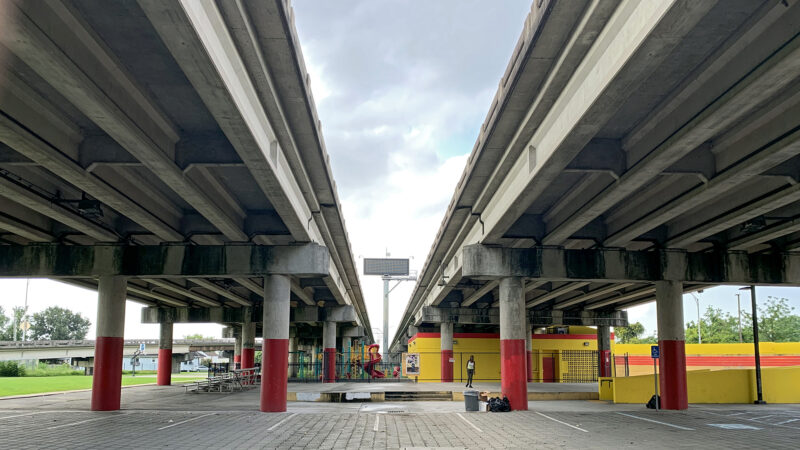In fight to remove divisive New Orleans highway, activists turn to new strategy — an EPA study
Hunter’s Field Playground sits beneath the Claiborne Expressway in New Orleans on July 18, 2023. Opened nine years ago, the playground is one of the monitoring sites of a new EPA study on the health impacts of the expressway.
Aside from the occasional discarded hypodermic needle on the ground, Hunter’s Field Playground looks immaculate — almost untouched. Despite opening more than nine years ago, the bright red and yellow paint on the slides and monkey bars is still sleek and shiny, and the padded rubber tiles are still spongy and pristine.
For people who live near the park, the reason it’s in such good condition is simple: “Kids never come here because kids are smart,” said Amy Stelly, who lives just over a block away on Dumaine Street. “It’s the adults who aren’t. It’s the adults who built the playground under the interstate.”
Hunter’s Field is wedged directly beneath the I-10 Claiborne Expressway in the city’s 7th Ward — sandwiched between the elevated highways. There are no sounds of laughter or children playing. The constant cuh-clunk, cuh-clunk of the traffic passing overhead makes it difficult to hold a conversation with someone standing next to you.
“I have never seen a child play here,” Stelly said.
Stelly is a local artist, an urban designer and an advocate with the Claiborne Avenue Alliance, a group of residents and business owners dedicated to remediating the expressway. For as long as she can remember, Stelly has been fighting to dismantle the Claiborne Expressway. She’s lived in the neighborhood for her entire life and said the noise is oftentimes unbearable.
“You can sustain hearing damage,” she said. “If we were out here all day and it was this loud all day — which it is for the most part — then at some point in time, it would affect our hearing negatively.”
Now, she and her organization are turning to a new strategy: an EPA-funded study on the health impacts — from pollution and heat to noise impacts — caused by the expressway. They hope the data will support them in their efforts to remediate and potentially remove the highway from their neighborhood.
A desire to address the issue
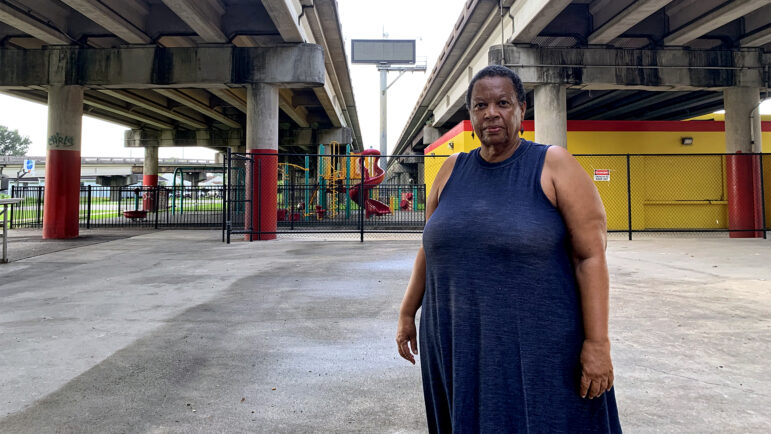
The Claiborne Expressway was built in the 1960s at a time when the construction of new interstates and highways was a symbol of progress and economic development in the U.S., and urban planning and transportation development were at the forefront of city agendas.
But that supposed progress often came at a great cost for marginalized communities — especially Black neighborhoods.
When it was built, the “Claiborne Corridor” as it’s sometimes known, tore right through the heart of Treme, one of the oldest Black neighborhoods in the country. For more than a century before the construction of the expressway, Claiborne Avenue was the center of economic and cultural life for Black New Orleans.
Then, the oak-lined avenue was home to more than 120 businesses. Today, there are only a few dozen left.
This racist legacy extends all across the country. In Montgomery, Alabama, I-85 cut through the city’s only middle-class Black neighborhood and was “designed to displace and punish the organizers of the civil rights movement,” according to Rebecca Retzlaff, an associate community planning professor at Auburn University. In Nashville, I-40 intentionally swerved around a white community, instead plowing through a prominent Black neighborhood, knocking down hundreds of homes and businesses. The list goes on and on.
But recently, the federal government has stated it wants to try to address the problem. An initiative established in the Biden Administration’s Infrastructure Investment and Jobs Act called Reconnecting Communities seeks to do just that — reconnect neighborhoods and communities that were divided by infrastructure.
Communities, city and state agencies and organizations across the country submitted proposals seeking federal funding — including Stelly’s group. In many ways, their proposal seemed like the perfect candidate. It’s a textbook example — even the White House said so in a statement on the program. But Stelly’s proposal was denied.
However, the city of New Orleans and the state of Louisiana submitted a separate proposal requesting the federal program cover half the cost of a $95 million plan that included funding for repairs and maintenance work on the expressway, as well as a public market and performance space beneath the highway. That proposal was approved, and so far, the Louisiana Department of Transportation and Development has only received $500,000 — more than $46 million less than they requested.
The city-state proposal included funding that could have potentially been used to remove some of the dangerous on- and off-ramps that make it difficult for pedestrians to safely walk through the neighborhoods beneath the expressway. There was also funding for projects aimed at public safety, like better lighting and pedestrian and bicyclist lanes.
‘You’re going to be exposed to the same thing’
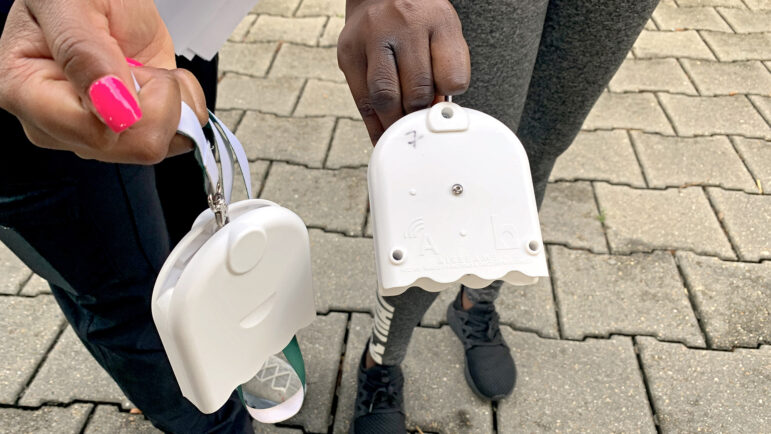
While it’s unclear what the smaller amount of grant money will be used for, Stelly said even the idea of creating an entertainment space and market beneath the highway — called the “Claiborne Innovation District” in the proposal — is misguided.
“It’s a foolish idea because you’re going to be exposed to the same thing,” Stelly said. “You’re going to be exposed to the same levels of noise. It’s not a wise decision to build anything under here.”
In addition to noise impacts, the EPA-funded study is also looking at the health impacts of pollution under the Claiborne Expressway — especially harmful pollutants like particulate matter 2.5, commonly known as PM 2.5.
Dr. Adrienne Katner, a professor at the LSU School of Public Health who is managing the EPA study, said PM 2.5 particles are very small particles that are typically released from the tailpipes of passing cars. They’re so small that when you inhale them they go deep into your lungs. From there, they can be transported into the circulatory system, where they can spread and impact every system in your body.
“So the heart, the brain. If a woman is pregnant, it can cross the placental barrier. So it has a lot of impacts,” Katner said.
The study is just getting started — Katner and her researchers are now taking preliminary readings with monitors at different points along the expressway. It will likely take two to three years to complete the study and publish the data.
Using science to inform policy
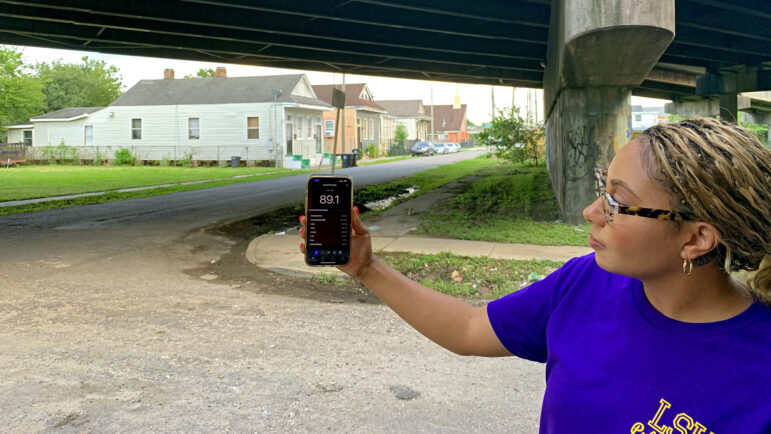
Hunter’s Field Playground is one of the locations along the Claiborne Corridor that the study is monitoring. Two of Katner’s graduate researchers, Jacquelynn Mornay and Beatrice Duah, took noise and pollution readings with monitors that upload data directly to the cloud and show them the results on their phones.
Mornay said the noise levels were as loud as a motorcycle engine up close and could cause permanent hearing damage after an hour or so of exposure. The pollution levels recorded hover around 18 micrograms per cubic meter.
“It should be at most, at most, 12,” Duah said. “So it is way over the limits.”
In addition to a playground, there are also homes and businesses lining the area beneath the expressway. The people who live and work here are exposed to these levels of noise and pollution day in and day out. While the EPA study is just getting started, there’s been a long history of research on how traffic pollution impacts the human body. Katner said the results of the study may not be too surprising.
“We’re not inventing the science here,” Katner said. “All I’m doing is showing them what we already know and then documenting it, giving them the data to then inform and influence policy. That’s all I can do.”
‘Removal is the only cure’
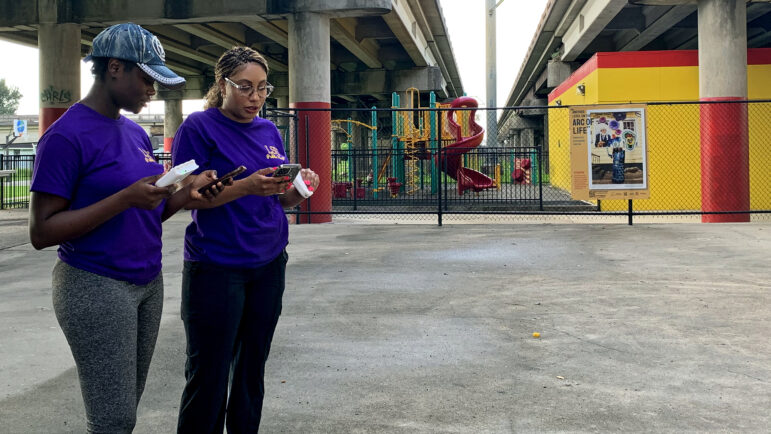
While this study is limited to just the I-10 Claiborne Expressway, Katner believes their findings could help other communities divided by infrastructure across the country.
“A lot of cities are going through this right now and they’re looking back at their highway systems,” she said. “They’re looking back at the impacts that it’s had on a community and they’re trying to figure out what to do next. I’m hoping that this project will inform them.”
The results of the study may not be surprising to Stelly, too. She said she’s always known the air she and her neighbors breathe isn’t safe, but she’s hopeful that having the data to support her efforts will make a difference and convince policymakers to address the problem. That could mean taking down dangerous on-and-off ramps — or scrapping the idea of putting a market and event space under the highway.
Still, there’s only one true solution here for Stelly; only one way to right the wrong done to her community.
“Removal is the only cure,” Stelly said. “I’m insisting on it because I’m a resident of the neighborhood and I live with this every day. But the science tells us there’s no other way.”
This story was produced by the Gulf States Newsroom, a collaboration between Mississippi Public Broadcasting, WBHM in Alabama, WWNO and WRKF in Louisiana and NPR. Support for health equity coverage comes from The Commonwealth Fund.
Top Instagram reels from Goats and Soda in 2025: Plumpy’Nut, aid cuts, soccer grannies
Our most-viewed Instagram videos include reports from a Rhode Island factory that makes special food for malnourished children and from a tournament for soccer-playing "grannies."
‘The Rest of Our Lives’ takes readers on a midlife crisis road trip
America's literary highways may be plenty crowded with middle-aged runaways fleeing lives that increasingly feel like a bad fit. But Ben Markovits adds a moving tale to the collection.
Hunker down with these 13 mysteries and thrillers from 2025
Mysteries and thrillers are enjoyable no matter the season, but there's something extra satisfying about curling up in the winter with a warm drink and an all-engrossing read. Here's what we suggest.
Should the U.S. model its vaccine policy on Denmark’s? Experts say we’re nothing alike
The Trump administration wants to revamp U.S. childhood vaccination recommendations to align with some other peer nations, including one tiny country in northern Europe.
Marijuana rescheduling would bring some immediate changes, but others will take time
President Trump set the process in motion to ease federal restrictions on marijuana. But his order doesn't automatically revoke laws targeting marijuana, which remains illegal to transport over state lines.
The cultural works becoming public domain in 2026, from Betty Boop to Nancy Drew
The original Betty Boop, the first four Nancy Drew books and Greta Garbo's first talkie are among the many works from 1930 that will be free to use, share and remake starting on Jan. 1.

